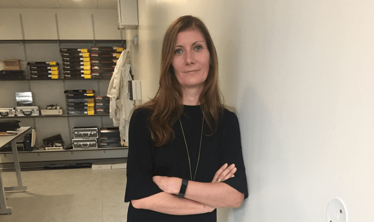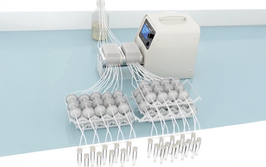All Hands on Spec
Sitting Down With... Karen Faulds, Professor, Department of Pure and Applied Chemistry, University of Strathclyde, Glasgow, UK.
Were you always interested in science?
As a small child, I was always asking “Why?” – I wanted to know how things worked, and a simple answer was never good enough! I also wanted to do something practical and work with my hands, to physically create something with meaning. I think that’s why I enjoy analytical science – it has a clear end goal, and many applications are instantly useful.

Why focus on SERS particularly?
I fell into SERS during my PhD. I was originally interested in forensic applications, and my PhD (partly sponsored by the Home Office) was on using SERS for the detection of drugs of abuse, with the eventual aim of developing a roadside saliva drug test, using a portable Raman instrument. Although my initial interest was in the forensic application of SERS, during my postdoc I started to look more at bioanalytical applications, in particular DNA detection.
What appealed to you about the technique?
It was a very exciting time when Ifirst started doing SERS. Raman instrumentation was developing rapidly – going from large laboratory instruments, to benchtop, to portable. The SERS technique was starting to develop into a quantitative technique and focus was shifting away from understanding the theory (which is still an important area of course!) into developing it into useful applications. SERS substrates were becoming more reproducible, along with a growing understanding of how to control surface chemistries – giving quantitative analytical results. This opened up lots of really exciting applications for SERS, and I was hooked!
Is instrumentation still advancing?
Absolutely. We now have high-end Raman instruments for fast, high-resolution imaging, but also handheld portable devices. We’re starting to reach the stage of “point-of-use” analysis – providing we get the SERS conditions and assays right, as well as creating high-resolution images that can give subcellular biochemical information.
What is the main focus of your work?
We’re developing biomarker detection using SERS for different disease states – sepsis, cardiovascular disease and cancer – and bacterial detection for clinical and food safety applications.
What’s the advantage of using SERS in those applications?
In short: sensitivity and multiplexing capabilities. Fluorescence can be equally sensitive, but it becomes challenging to differentiate multiple fluorescent components in a mixture because the output is a broad band spectrum; if you have multiple bands present, they start to overlap – particularly when only one excitation wavelength is used. With Raman, because you’ve got the molecularly specific vibrational fingerprint spectrum, you can start to deconvolute more within a mixture. We’re aiming to get more information back per sample – to detect and quantify multiple analytes in one analysis. We want to be able to do one test rather than three or four, and then move these tests into “point-of-use” environments. I look forward to the day (hopefully in the near future!) when we get that test into the clinic, where it can help speed up diagnosis and lead to earlier medical interventions.
You’re an advocate of multidisciplinary research – why is that so important?
In our work, clinical input is vital. For example, there is no point in developing a test or trying to understand a disease pathway that is of no help to a clinician either in terms of diagnosis and/or treatment. Early discussion with biomedical scientists and clinicians is vital in directing research towards what will actually make a difference. These problems can’t just be solved by one discipline - you can’t be an expert in every area, and that’s why you work as part of a team. Luckily, I enjoy interacting with people! I have had the privilege to be involved in multidisciplinary teams (chemists, biologists, physicists, clinicians, engineers) for most of my career and much prefer working in a team towards a common goal, rather than working in isolation.
You’re also actively involved in educating the next generation...
That’s right; I work closely with Duncan Graham at Strathclyde - we run our research groups together and training PhD students is very important. In addition, I am the Strathclyde Director of the Centre for Doctoral Training in optical medal Imaging (OPTIMA), which is a joint venture between the University of Strathclyde and the University of Edinburgh. We’re training 60 PhD students over five years and each student has a physical sciences advisor, and a clinical or biomedical supervisor. Students won’t just get a thorough grounding in the scientific aspects, but will also cover entrepreneurship and the translation of science – the collaborative environment fosters creativity and sparks ideas for new research areas. It is a continual privilege to get the chance to work with such a fantastic group of students and postdocs.
What’s next for you and your lab?
We’re about to start a program on bacterial detection in food. We’ve looked at bacterial detection before, but never in the food production environment – so there is a whole new set of issues. Currently, testing for bacterial contamination in food is done off-site – samples are sent to a central lab, where it can take a week to get results. That’s a long time if food has been contaminated. Our aim is to detect bacteria “on the line” to save both time and money. Bacteria multiply very quickly, so if contamination is suspected, everything has to be sterilized and production has to start again – it’s a costly process. Faster testing using SERS could also help with traceability – where has that contamination come from, and how has it spread?
Professor of Chemistry, University of Strathclyde, UK.

















